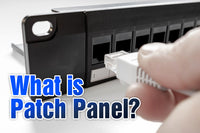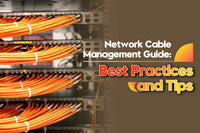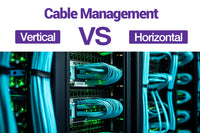As is known to all, cable management is essential in cable deployment for the best network performance. Fiber patch panels have indeed contributed to the maintenance and management of fiber optic cables. With the increasing requirements for high-density cabling systems, fiber optic patch panels have become more and more important in data centers. We’ll introduce the definitions, structures, types, and benefits of fiber patch panels in this article.
What is a Fiber Optic Patch Panel?
The fiber optic patch panel, also known as the fiber distribution panel, serves as the crucial component of the management of fiber optic cables. It is usually a metal panel consisting of an array of ports to provide connection to individual pre-terminated fiber optic cables or spliced fibers. These patch panels provide a secure environment for fiber cables, fiber connectors, and spliced units, which are often used in data centers, server rooms, and telecommunication devices for efficient and reliable network performance.
The fiber optic patch panel is usually composed of two parts: one is designed for receptacles or adapters, and the other is made for splice trays or excess fibers. It usually consists of three components: an adapter panel, a connector adapter, and a splice tray. The adapter panel can hold the connector couplers, the connector adapter provides low-loss fiber optic transmission by effectively mating connectors, and the splice tray is designed to organize the splicing modules and fix them into place.
Types of Fiber Patch Panels
Fiber patch panels are available in different types to meet specific requirements. For example, outdoor patch panels are often used directly outdoors, which can provide resistance to dust and water. Here is an overview of various types of fiber patch panels:
Rack-mount vs. Wall-mount
The drawer-like rack-mount fiber patch panel often features horizontal 19” or 23” racks, which can hold up to 288 fibers. The height of the rack-mount patch panel is typically measured in Rack Units (RU) or U, meaning the space between the mounting points. These panels are designed to store fiber optic cables, facilitate cable splicing and termination, and protect cables, fibers, and connectors. Rack-mount fiber patch panels are available in two popular panels: flip-type and drawer-style panels.

Wall-mount fiber optic patch panels are also very commonly used in outdoor or indoor fiber cable interconnection applications. They also allow for cable splicing and termination and help protect the termination part. Often equipped with safety devices, wall-mount fiber optic patch panels come in various sizes and styles to meet diverse fiber needs.
Based on Rack Size
As mentioned above, the rack height is measured in RU or U units, with one rack unit equaling 1.75 inches (44.45mm). Rack sizes can range from 1U to 2U, 4U, and beyond. The 1U size is most commonly used in fiber installations, while 2U and 4U sizes are designed for high-density environments.
Indoor Use vs. Outdoor Use
Fiber patch panels can be installed in both indoor and outdoor environments. Indoor panels are often used in data centers, server rooms, or office buildings. Outdoor fiber patch panels are designed for harsh outdoor conditions, providing resistance to moisture, dust, UV radiation, and temperature fluctuations.
Categorized by Port Numbers
Fiber patch panels are available in a wide range of port configurations to accommodate the diverse cabling needs across various densities. Panel ports range from 12, 24, 48, 72, 288, and even more. 12-port, 24-port, and 48-port panels are widely used in data center applications. High-density fiber patch panels play a crucial role in optimizing space utilization, making them ideal for large-scale fiber network installations.
Categorized by Connector Types
As is known to all, fiber optic cables are coupled with various fiber connectors, and fiber patch panels are specifically designed to accommodate these fiber connectors, such as LC, SC, and MTP/MPO connectors. In the data center setting, LC and MTP panels are widely used.
Single-mode vs. Multi-mode Patch Panel
Fiber patch panels can also be categorized into single-mode and multi-mode types based on the fiber type. Single-mode patch panels are designed for single-mode connectors like LC and SC connectors for high alignment. Multimode patch panels fit multimode connectors, which are suitable for short-distance networking.
Loaded vs Unloaded Fiber Patch Panels

Loaded fiber patch panels are loaded with adapter panels or fiber cassettes and these adapter panels are often designed for LC and MTP connectors. In contrast, unloaded patch panels are just empty panels and you can opt for the adapter panels that you want. Compared to loaded ones, unloaded patch panels are more flexible as you can choose one that is best suited for you, but they can be a bit more costly.
Enclosed vs. Open Patch Panels
Open patch panels allow the fiber patch cords access from the front or rear, providing added flexibility. But it is placed in the open air. Open panels usually feature metal frames and protect fiber cables by using fiber cassettes. Based on open types, there are several panels including drawer-type, and rotation-type and dust-proof patch panels. The drawer type can be pulled out or pushed back easily; The rotation type adopts a rotated structure; The dust-proof type comes with a metal cover that keeps dust away. Enclosed panels can protect fiber patch cables and fibers from abrasion, dust, and physical damage. They provide extra protection and security for stable data transmission.
Benefits of Using Fiber Patch Panels
With the increasing demand for fiber optic networks, fiber panels have become more and more important. Fiber patch panels offer a range of benefits that contribute to efficiency, reliability, and scalability. Here are some common benefits of fiber optic patch panels:
- Facilitate better organization and management of various fiber cables;
- Provide a more accessible location for all input jacks or ports, allowing for an easier connection to devices mounted onto racks;
- Simplify the process of moving, adding, and replacing fiber optic cables, making the panel a centralized pointwhere any change to cables can be made;
- Protect the input ports of valuable network equipment from abrasionand elongate the lifespan of the equipment;
- Make fiber optic cables easy to terminate.
How to Choose Fiber Patch Panels?
Choosing fiber patch panels can sometimes be confusing and you need to consider several key factors to future-proof your network infrastructure. There are some factors you need to consider when selecting a fiber patch panel.
- Installation Location: You should determine whether you’ll install the fiber patch panels indoors or outdoors. If you want to place it indoors, a standard panel is ok, but If you want to place it outdoors, you need to assess environmental factors such as wind, rain, and dust. A metal-enclosed fiber panel is recommended for outdoor applications for a long service life.
- Capacity: It refers to rack size, panel capacity, and port density. Among common sizes of 1U, 2U, and 4U racks, 1U racks are commonly used in data centers; 2U and 4U racks are also widely used for other high-density applications. Compared to loaded fiber optic patch panels, unloaded panels are more flexible in expanding capacity, type, and number of fiber optic ports. Some patch panels now feature up to 288 or even more ports. If you want to use a panel for a high-density space such as a server room or data center, a panel with more ports can reduce rack footprint and save valuable space.
- Compatibility: You should consider the compatibility not only between patch panel connectors and connectors on the fiber panel but also between the fiber optic equipment and those that require optical connection via the patch panel.Sometimes, the selection of fiber patch panels requires a specific polarity of multi-fiber connectors and inserted connectors. It is advisable for you to choose those fiber patch panels that can support a wide range of fiber connectors.
Summary
Patch panels for fibers provide a reliable and flexible way to maintain a neat and organized network. Opting for a correct fiber patch panel can ensure efficient, reliable, and safe data transmission. Hope this article can help you learn more about fiber patch panels.
FAQs
What are fiber optic patch cables used for?
Fiber optic patch cables are pre-terminated with fiber optic connectors on both ends and they are mainly used for indoor applications such as server rooms, data centers, and Cable TV networks.
What is the difference between a fiber distribution panel and a patch panel?
The fiber distribution panel is used to distribute optical signals in fiber optic networks; The patch panel includes the ethernet patch panel and the fiber patch panel.
Do fiber patch panels reduce speed?
No, fiber patch panels are only a place for accommodating fiber optic cables and fibers. However, poorly designed or improperly installed patch panels may potentially introduce signal loss or degradation.
For more information on this topic, you can keep up on our blogs. While VCELINK offers general and basic information for our customers and other visitors to the website, it’s not professional advice.



Be the first one to comment.
Leave a comment